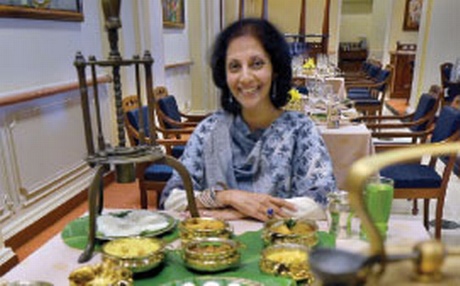
Writer and foodie Kaveri Ponnapa’s face lights up whenever she speaks about the traditional food of her forefathers, the warrior race—the Kodavas. She has endeavoured to capture the essence of Kodava cuisine by training and guiding the chefs of Dakshin, ITC Windsor hotel in Bangalore. Kaveri is all praise for the dedicated chefs and pronounces their Kodava food as almost as good as what’s cooked at home. And coming from her, that’s saying a lot.
Kaveri has spent years studying and documenting the food and culture of the people of Coorg which is a tiny hilly district near coastal Karnataka and has a distinct history and customs quite unlike the rest of the state. She picked up recipes and tips from her grandmother and later from her mother-in-law and is a brilliant cook herself.
The Coorgs or Kodavas migrated from the Eastern Mediterranean and are a fiercely proud and clannish community. They lived close to Mother Nature and lived on seasonal fruit and vegetables and grew paddy on the flatter lands and valleys as well as on the slopes. Their food is hence a rich mix of rather exotic forest produce and rice. Various items are made out of rice and broken rice as in other parts of South India like puttu and akki tari or broken rice flour which is used to make akki otis, a Coorg substitute for wheat flour rotis.
The key flavour in every Coorg dish is that of sourness which is thanks to concentrated vinegar, the much loved signature kachampuli made from a fruit that is from the same family as kokum or from local bitter oranges, kaipuli. “These days there is a big demand for this unique vinegar and there is adulteration happening so one should buy it only from reliable sources,” cautions Kaveri.
A largely meat and pork eating people with the ubiquitous Pandi (pork) curry being a much loved and best known Kodava dish. There are a lot of vegetarian dishes much to the delight of the uninitiated diner. The mushroom curry which is quite sweet and cooked in coconut could almost pass off as a Thai dish. Red pumpkin curry with grated coconut is delicious with rice flour rotis. The Kodavas make a variety of dishes from beans, double beans and wild greens which are tasty and subtly flavoured. Kaveri chose to be vegetarian for many years and would experiment and try out veggie recipes rather diligently.
Trade has certainly influenced the cuisine and one fine example is that of ghee rice which is usually eaten with chicken curry and definitely has a strong resemblance to a rice dish in Maplah cuisine.
The Kodavas were famed hunters informs Kaveri and they ate everything they hunted whether it was quails, partridges, venison. The monsoon was a long wet season so meats were dried and smoked and mushrooms which grow abundantly everywhere were dried and preserved. Almost every village household had a little kitchen garden where a variety of herbs, spices and vegetables like pumpkins, gourds, greens were grown, bamboo shoots and mushrooms thrived. “Foraging was a part of our culture and nothing went to waste,” says Kaveri.
Preserving techniques like pickling and salting were common and are used even today. Apart from the sour flavour, unique to Coorg, many dishes have a touch of bitterness thanks to dry roasted and then powdered fenugreek seeds. Roasted rice grains are used as thickeners in some dishes.
Kodavas do not have many desserts and dishes like banana fritters and steamed ripe jackfruit pulp served with grated coconut and a bit of jaggery are perfect. Kaveri has a website www.coorg.com with information on the history and cuisine of her people.
source: http://www.newindianexpress.com / The New Indian Express / Home> LifeStyle> Food / by Sangeeta Cavale Radhakrishna / December 22nd, 2013

